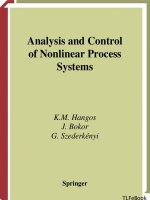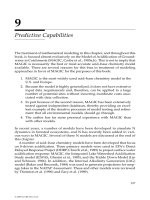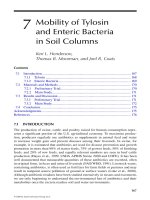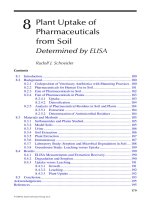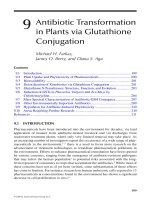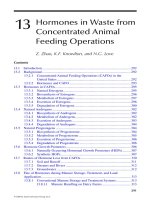Analysis and Control of Linear Systems - Chapter 9 pot
Bạn đang xem bản rút gọn của tài liệu. Xem và tải ngay bản đầy đủ của tài liệu tại đây (482.54 KB, 32 trang )
Part 2
System Control
This page intentionally left blank
Chapter 9
Analysis by Classic Scalar Approach
9.1. Configuration of feedback loops
9.1.1. Open loop – closed loops
The block diagram of any closed loop control system (Figure 9.1) consists of an
action chain and of a reaction (or feedback) chain which makes it possible to
elaborate an error signal
),(tε the difference between the input magnitude )(te and
the measured output magnitude
)(tr . The output of the system is ).(ts
Figure 9.1. Block diagram of a feedback control
When the system is subjected to interferences b(t), its general structure is
represented by Figure 9.2 by supposing that its working point in the direct chain is
known. We designate by
)(),( pRpE ,
ε
(p) and )( pS the Laplace transforms of the
input, the measurement, difference and the output respectively (see Figure 9.2).
Chapter written by Houria SIGUERDIDJANE and Martial DEMERLÉ.
254 Analysis and Control of Linear Systems
Figure 9.2. General block diagram
The open loop transfer function of this chain is the product of transfer functions
of all its elements; it is the ratio:
()
() ()()
12
()
Rp
ppp
p
µµ β
ε
= [9.1]
The closed loop transfer function of this chain is the ratio
)(
)(
pE
pS
with:
ε(p)= )()( pRpE − [9.2]
We have:
21
() ()(() ()Sp p Bp p
µ
µ
=+ε(p)) [9.3]
and:
)()()( pSppR
β
= [9.4]
by using equation [9.2] and by eliminating
)( pR and
ε
(p) of equations [9.3] and
[9.4], we obtain:
() () ()
12 2
() () ()
1 () ()() 1 () ()()
12 12
pp p
Sp Ep Bp
ppp ppp
µ
µµ
µµ β µµ β
=+
++
[9.5]
Analysis by Classic Scalar Approach 255
When the interferences are zero, 0)( =pB , the transfer function of the looped
system is then:
() ()
()
12
() 1 () ()()
12
pp
Sp
Ep p p p
µ
µ
µµ β
=
+
[9.6]
or simply:
() ()
() 1 ()()
Sp p
Ep p p
µ
µβ
=
+
[9.7]
by supposing that
12
() () ()ppp
µ
µµ
= .
The transfer function with respect to the interference input is obtained by having
0)( =pE in equation [9.5]:
()
()
2
() 1 () ()()
12
p
Sp
Bp p p p
µ
µµ β
=
+
[9.8]
9.1.2. Closed loop harmonic analysis
Bandwidth
The bandwidth of a system is the interval of angular frequencies for which the
module of open loop harmonic gain is more than 1 in arithmetic value:
()() 1jj
µωβω
>> [9.9]
Approximate trace
In order to simplify the determination of closed loop transfer functions, we can
use the approximations [9.10] and [9.11]:
If
1)()( >>
ωβωµ
jj then
)(
1
)(
)(
ωβω
ω
jjE
jS
≈
[9.10]
If
1)()( <<
ωβωµ
jj then )(
)(
)(
ωµ
ω
ω
j
jE
jS
≈ [9.11]
256 Analysis and Control of Linear Systems
Figure 9.3 shows, in Bode plane, the approximate trace (in full line), of the gain
curve of the closed loop frequency response.
Figure 9.3. Approximate trace of the closed loop harmonic response
Point A, in particular for integrator systems, is often rejected at 0=
ω
.
9.1.2.1. Black-Nichols diagram
The Black-Nichols diagram makes it possible to graphically pass from the open
loop system to the closed loop system. This diagram corresponds to a unitary
feedback. The chart in Figure 9.4 is usable for open loop gains going from –40 dB to
+40 dB and a phase difference between 0° and –360°.
Figure 9.4. Black-Nichols diagram
Analysis by Classic Scalar Approach 257
When the feedback is not unitary, the transfer function can be re-written as a
unitary feedback gain transfer function that is divided by the return gain
β
because:
1
()
11
Fp
µµβ
µ
βµββ
==
++
[9.12]
9.1.2.2. Estimation of closed loop time performances from the harmonic analysis
The closed loop (CL) frequency response is characterized by the quality
factor
r
Q , also called magnification Q, i.e. the passage from the module through a
maximum to an angular frequency
r
ω
called resonance angular frequency.
The time response is characterized, for a step function input, by the time of the
first maximum
m
t and the overflow D, as indicated in Figure 9.5a, i.e.
∞∞
−= sssD /)(
max
where
max
s represents the maximum value obtained from the
output to instant
m
t and
∞
s that obtained in permanent state. The overflow is
expressed as a percentage.
Figure 9.5. (a) Time response in CL and (b) frequency response in CL
258 Analysis and Control of Linear Systems
When the system has good damping, let
ξ
be the value of the damping
coefficient delimited between 0.4 and 0.7, we have the relation
3≈
mc
t
ω
, where
c
ω
represents the gap angular frequency. It is the angular frequency for which the
open loop arithmetic gain is equal to the unit. For a well damped system, the quality
factor
r
Q has a value of less than 3 dB.
9.2. Stability
A looped system is called stable if its transfer function:
()
()
1()()
p
Fp
pp
µ
µβ
=
+
[9.13]
does not have poles of positive or zero real part.
In other words, the necessary and sufficient condition of stability of such a
system is that
)( pF has all its poles with a negative real part.
When the denominator of
)( pF is a polynomial of order higher than 3 and does
not reveal any obvious root, the analytical calculation of the roots may be fastidious.
To study the stability, we then use either the geometrical criterion called Nyquist,
where we reason only on the open loop in order to determine the stability of the
closed loop or the so-called Routh algebraic criterion where we reason on the
)( pF
specific equation without calculating its roots.
We can firstly show that the stability of a linear closed loop control system is
connected to the diagrams of its open loop frequency response.
The transfer functions
)( p
µ
and )( p
β
are in general in the form of polynomials
in
p :
)(
1
)(
1
)(
pD
pN
p
=
µ
and
)(
2
)(
2
)(
pD
pN
p
=
β
[9.14]
then:
)(
2
)(
1
)(
2
)(
1
)(
2
)(
1
)(
pNpNpDpD
pDpN
pF
+
=
[9.15]
Analysis by Classic Scalar Approach 259
The system’s characteristic equation is:
0)(
2
)(
1
)(
2
)(
1
=+ pNpNpDpD [9.16]
or:
0)()(1 =+ pp
β
µ
[9.17]
The system is stable if equation [9.17] does not have zeros of positive or zero
real part.
NOTE 9.1.– the methods presented in this chapter are valid when the open loop
transfer function
()()pp
µ
β
does not result from a set of transfer functions
presenting simplifications of the poles-positive real part zeros type.
9.2.1. Nyquist criterion
This criterion is based on the traditional property of analytical functions and it
makes it possible to predict the behavior of a looped system by only knowing the
open loop. To do this, we use the following Cauchy’s theorem.
When a point M of affix p describes in the complex plane a closed contour C
(Figure 9.6a), clockwise, surrounding P poles and Z zeros of a function
)( pA of the
complex variable p, then the image of the point M through application A surrounds
PZN −= times the origin in the same direction. We suppose that there is no
singularity on C.
If we take, for example,
2=
Z
and 3=P , then 1−=N , the point M makes 1
tour around the origin, in counterclockwise direction (Figure 9.6b).
Figure 9.6. Plane of the complex variable p and plane of )( pA
260 Analysis and Control of Linear Systems
The application to the Nyquist criterion leads to consider the transformation
)( pA as being the denominator of the transfer function of the looped system. We
want this transfer function not to have poles of positive real part and hence its
denominator:
)()(1)( pppA
β
µ
+= [9.18]
not to have positive real part zeros. We then choose as contour C a semicircle of
infinite radius in the complex semi-plane on the right of the imaginary axis. C is
called the Nyquist contour. The image of C through
)( pA transformation must thus
surround the origin, in a counterclockwise direction, as many times as the number of
unstable poles of equation [9.18] and hence of
()()pp
µ
β
.
Figure 9.7. Contour and image of the Nyquist curve
Contour C is chosen in such as way as to surround the poles of possible zeros of
)()(1 pp
β
µ
+ with strictly positive real part. If C contains, for example, 1=
Z
zero
and
3=P poles (Figure 9.7a), the Nyquist diagram will make 2−=N circuits
around the origin in a clockwise direction and it will go around twice in a
counterclockwise direction (Figure 9.7b).
To be stable in closed loop, it is necessary that z = 0, the image of C must then
make N = – P circuits around the origin. If the open loop transfer function
)()( pp
β
µ
is stable, we have
0=P , the image of C through the transformation )()(1 pp
β
µ
+
should not surround the origin. However, the number of circuits made around the
origin in the transformation
)()(1 pp
β
µ
+ is equal to the number of circuits made
around the critical point –1 in the transformation
)()( pp
β
µ
.
In what follows, we will deal only with this latter transformation and we will
study the case of open loop stable systems, that of integrator systems and finally the
case of open loop unstable systems.
Analysis by Classic Scalar Approach 261
Case 1. Open loop stable system: Nyquist diagram
Let us take the example:
()()()
cpbpap
K
pp
+++
=
)()(
βµ
[9.19]
where a, b and c are positive. Contour C and the Nyquist image corresponding curve
are given by the graphs in Figure 9.8.
Figure 9.8. Contour and image of Nyquist curve
The image of the semicircle of infinitely high radius, through this transformation,
is reduced to a point, which in general is the origin (the systems that can be
physically created always have zero gains for infinite angular frequencies).
The image of the radius
[,0] ∞+
+
is the curve in Figure 9.8b, corresponding to
the trace of the open loop frequency response and described in the direction of
increasing ω . The image of the ray
[0,]
−
∞− is the symmetric curve of Nyquist
place, with respect to the axis of real numbers. We can easily show this symmetry
from the expression of the open loop transfer function. In fact, based on the
definition:
∫
∞
−
=
0
)()()(
θ
ωθ
θβµ
d
j
ehpp
[9.20]
where
)(
θ
h represents the impulse response of the open loop system, i.e.:
[]
∫
∞
−+−=
0
)sin()cos()()()(
θωθωθθωβωµ
djhjj
[9.21]
262 Analysis and Control of Linear Systems
we have:
[]
∫
∞
−=−−
0
)sin()cos()()()(
θωθωθθωβωµ
djhjj
[9.22]
or:
µ
ωβ ω µ ωβ ω
−−=
___________
( )( ) ()()jj jj [9.23]
Case 2. Open loop integrator system
Let us take the example:
)(
)()(
app
K
pp
+
=βµ
[9.24]
where
a
is positive.
Contour C is chosen in such a way as to exclude the origin as indicated by Figure
9.9a. This contour does not contain the unstable poles
)0( =P . Let
ε
C be the circle
of radius
ε
,
θ
ε
j
ep = (Figure 9.9c).
The image of the ray
[,0] ∞+
+
is the trace of the frequency response in open
loop covered in the direction of increasing ω . When
+
→ 0
ω
, the gain of
∞→)()( pp
β
µ
and the phase is of 2/
π
− . When
+∞→
ω
, the gain 0→ and the
phase is of
π
− . The image of the ray [0,]
`−
∞− is the symmetric curve, with
respect to the axis of real numbers. The image of the semicircle of radius
ε
is an arc
of circle of radius
∞ . When 0→p ,
θ
ε=→βµ
j
eKpKpp //)()( . If
ω
increases
from
−
0 to
+
0 ,
θ
varies from 2/
π
− to 2/
π
+ and the open loop gain is infinite.
Analysis by Classic Scalar Approach 263
Figure 9.9. The choice of the contour of C excludes the origin (a), the transform
of the contour C (b), C
ε
circle of radius
ε
, p =
ε
e
j
θ
(c)
The image of the semicircle of an infinitely big radius is the origin of the
complex plane. The transform of contour C, representing the complete Nyquist
place, is represented by Figure 9.9b.
NOTE 9.2. – when the open loop transfer function
)()( pp βµ has terms of the form
/
k
K
p with 1>k ,
θ
varies from 2/
π
k− to 2/
π
k+ and )()( pp βµ describes
infinite k semicircles in a clockwise direction.
Statement of Nyquist criterion
A looped system is stable (bounded input-bounded output) if and only if the
Nyquist place of its open loop transfer function
)()( pp
β
µ
, which is described in
the direction of increasing angular frequencies, does not go through the critical point
– 1 and makes around it a number of circuits in the counterclockwise direction equal
to the number of unstable poles of
)()( pp
β
µ
.
Case 3. Unstable system in open loop
EXAMPLE 9.1.– the Nyquist trace is given in Figure 9.10.
()
pp
K
pp
21
)()(
−
=
βµ
[9.25]
264 Analysis and Control of Linear Systems
Figure 9.10. Nyquist trace, open loop unstable system
We have P = 1, this system, which is unstable in open loop, is equally unstable in
closed loop because the Nyquist place does not surround once the critical point –1.
EXAMPLE 9.2.
()
()
pp
pK
pp
1.01
2
1
)()(
+
+
=
βµ
[9.26]
The Nyquist trace is given in Figure 9.11a.
Figure 9.11. Nyquist trace, open loop stable system (a), closed loop stable system (b)
We have 0=P ; this system, which is stable in open loop, is equally stable in
closed loop because the Nyquist place does not surround the critical point – 1.
Analysis by Classic Scalar Approach 265
EXAMPLE 9.3.
)1.01)(51(
2
)2.01)(1(
)()(
ppp
ppK
pp
++
++
=
βµ
[9.27]
The Nyquist trace is given in Figure 9.11b. We have
0=P , the stability of the
closed loop depends on the value of K. Let
α
be the meeting point of the curve with
the axis π− (as indicated in the figure). If
01 <<−
α
, the looped system is stable
because Nyquist place does not surround the point –1, if
1−<
α
, the looped system
is unstable.
Simplified Nyquist criterion: reverse criterion
A simplified criterion can be deduced from the previous criterion.
A system, stable in open loop, is stable in closed loop if, covering the Nyquist
place of the open loop in the direction of the increasing
ω
, leaves the critical point
on the left (Figure 9.12a). If it leaves the critical point on the right, it is unstable
(Figure 9.12b). If the gain curve
)(
ω
µβ
j goes through the critical point, the system
is oscillating (Figure 9.12c).
Figure 9.12. Stable system (a), unstable system (b), oscillating system (c)
9.2.2. Routh’s algebraic criterion
This criterion formulates a necessary and sufficient condition so that any n
degree polynomial has all its roots of strictly negative real part.
We re-write the characteristic equation [9.17] in the polynomial form:
µβ
−
+=+ +++
−
…
1
1()()
110
nn
p
pap a p apa
nn
[9.28]
266 Analysis and Control of Linear Systems
Then, we create Table 9.1 (with n + 2 rows).
1 a
n
a
n-2
a
n-4
…
2 a
n-1
a
n-3
a
n-5
…
3 b
1
=a
n-2
-a
n
a
n-3
/a
n-1
b
2
=a
n-4
-a
n
a
n-5
/a
n-1
b
3
=a
n-6
-a
n
a
n-7
/a
n-1
…
4 c
1
=a
n-3
-b
2
a
n-1
/b
1
c
2
=a
n-5
-b
3
a
n-1
/b
1
c
3
=a
n-7
-b
4
a
n-1
/b
1
…
… …. … … ….
n+1 … 0 … …
n+2 0 0 0 0
Table 9.1. Routh’s table
For a regular system, the number of non-zero terms decreases with 1 every 2
rows and we stop as soon as we obtain a row consisting only of zeros. The first
column of Routh’s table has n + 1 non-zero elements for a characteristic equation of
n order. The roots of this equation are of strictly negative real part if and only if the
terms of this first column of the table have the same sign and are not zero.
Statement of Routh’s criterion
A system is stable in closed loop if and only if the elements of the first column of
Routh’s table have the same sign.
EXAMPLE 9.4.– let us consider again example 9.1 :
)21(
)()(
pp
K
pp
−
=βµ
[9.29]
The characteristic equation is
0)21( =+− Kpp or 02
2
=++− Kpp . The first
two coefficients (which are the first two elements of the first column of Routh’s
table) are of opposite signs, the looped system is unstable.
Analysis by Classic Scalar Approach 267
Let us now take example 9.2:
)1.01(
2
)1(
)()(
pp
pK
pp
+
+
=
βµ
[9.30]
The characteristic equation is
0)1()1.01(
2
=+++ pKpp or by developing
01,0
23
=+++ KKppp .
Routh’s table gives:
0.1 K
1 K
K-0.1K 0
K 0
The system is stable in closed loop if
0>K .
NOTE 9.3. – a necessary condition to have negative real part roots is that all
i
a coefficients have the same sign.
9.2.3. Stability margins
The physical systems are represented by mathematical models which are
generally not very exact. The stability of the mathematical model does not
necessarily entail that of the physical system. Consequently, in order to take into
account the uncertainties of the model, security margins must be defined during the
theoretical study in order to ensure a satisfactory behavior to the looped system,
especially when the Nyquist place of the harmonic response in open loop is near the
critical point.
a) Phase margin – gain margin
The phase margin is obtained by calculating the difference between the system
phase considered and –180° to the gap angular frequency. The gain margin is
obtained by calculating the difference between the system gain and 0 dB to the
angular frequency where the phase reaches –180°. These margins, noted by
φ
∆
and
G∆ , are represented in Bode, Nyquist and Black-Nichols planes in Figure 9.13.
268 Analysis and Control of Linear Systems
Figure 9.13. Bode plane (a), Nyquist plane (b), Black-Nichols plane (c)
In Bode and Black-Nichols planes:
)180(
o
−−=∆
φφ
to the angular frequency
c
ω
for which 0=
µβ
dB
dB
G
µβ
−=∆ dB0 to the angular frequency
π
ω
ω
= for which
o
180−=
φ
In Nyquist plane:
φ
∆ is represented by the angle ),( MONO
where 1==
µβ
OM (0dB)
xG log20−=∆ where x
µ
β
= to the angular frequency
π
ω
ω
= for which
o
180−=
φ
When a system is at a minimal phase difference, i.e. when all its zeros are of
negative real part and of low-pass type, the only consideration of the phase margin is
enough in general to ensure a convenient damping.
b) Delay margin – module margin
The delay margin, for a stable system with a phase margin
φ
∆ is defined as
being the ratio:
c
m
ω
φ
τ
∆
=
[9.31]
Analysis by Classic Scalar Approach 269
where
c
ω
is the gap angular frequency. The delay margin represents the maximum
allowed delay value leading exactly to the cancellation of the phase margin.
The module margin represents the shortest geometrical distance between curve
µ
β
and point –1.
Figure 9.14. Nyquist plane
c) Degree of stability of a second order system
Let us consider a second degree system whose closed loop transfer function, with
a unitary feedback, has the form:
2
00
2
2
0
2
)(
ωξω
ω
++
=
pp
pF
[9.32]
where
ξ
represents the damping coefficient and
0
ω
is the system’s angular
frequency. If
ξ
is low, the unit-step response is oscillating, if
ξ
is high, the
response is strongly damped and the transient state is long.
The magnification
r
Q , i.e. the maximal gain of the closed loop module curve,
which can be measured directly in the Black-Nichols plane (Figure 9.15), is related
to the damping coefficient by the relation:
2
12
1
ξξ
−
=
r
Q [9.33]
270 Analysis and Control of Linear Systems
We note that when
ξ
tends towards zero,
r
Q tends towards infinity. The
resonance angular frequency is given by the relation:
2
0
1
ξωω
−=
r
[9.34]
For a conveniently damped system,
r
Q is less than 3 dB or a damping
coefficient lower than 0.7. We can verify, with the help of a Black-Nichols diagram,
that in order to have
dB3≤
r
Q , we need a phase margin
0
45≥∆
φ
and a gain
margin
dB5≥∆G
.
Figure 9.15. Black-Nichols plane
d) Degree of stability of any order system
When a system has any order transfer function, there will not be an explicit
damping coefficient like in the case of second order system. However, the responses,
with an equal resonance coefficient, have almost the same form. Hence, we can
measure the degree of stability of any order system by its resonance factor in the
Black-Nichols plane.
9.3. Precision
In section 9.1.1 we saw the general block diagram of a closed loop control
system (Figure 9.2). The role of such a system is to follow the output s(t) with the
input e(t). Signal e(t) injected at the input of the system is ideally the signal that we
would want to obtain at the output. In the case of a perfect feedback control, the
difference
)()()( trtet −=
ε
is then zero at every instant. In the case of a real
feedback control, this difference is never zero due to the time constants of physical
Analysis by Classic Scalar Approach 271
systems, on the one hand and to the interferences acting on the system on the other
hand.
The quality of the feedback control is mainly translated through its stability and
the follow-up precision of the output on the input and consequently of the dynamics
of this difference. The precision study makes sense only if the system is stable.
In practice, it is interesting to know the permanent error, also called static,
s
ε
which is the asymptotic value of the instantaneous error
d
ε
, called dynamic.
The specifications on the error are most often formulated in one of the following
forms:
– bounded or zero static error in response to the inputs or canonical interferences
(step function, ramp, harmonic signal);
– bounded dynamic error
max
ε
ε
<
d
for the inputs having certain given
characteristics.
In the presence of an interference, due to the overlapping principle, we have:
ε(p) = ε
e
(p) + ε
b
(p) [9.35]
where:
ε
e
(p)= )(
1
1
21
pE
βµµ
+
[9.36]
and:
ε
b
(p)= )(
1
21
2
pB
βµµ
βµ
+
−
[9.37]
These expressions are calculated by considering firstly the zero interferences
0)( =tb ( 0)( ≠te ; see Figure 9.16a) and then the zero input 0)( =te ( 0)( ≠tb , see
Figure 9.16b).
272 Analysis and Control of Linear Systems
Figure 9.16. Zero interferences b(t) = 0, e(t)
≠
0 (a), zero input e(t) =0, b(t)
≠
0 (b)
9.3.1. Permanent error
9.3.1.1. Step function input – zero interference
When the input signal is a step function
)( pE of amplitude
0
E , pEpE /)(
0
= .
Equation [9.36] then becomes:
ε
e
(p) =
()
βµµ
21
0
1+p
E
[9.38]
The theorem of the final value makes it possible to write:
0
lim)(lim
→∞→
=
p
e
t
t
ε
p ε
e
(p)
()
βµµ
21
0
0
1
lim
+
=
→
E
p
[9.39]
This error is zero if
β
µ
µ
21
1+ has at least one pole at the origin, i.e. if
β
µ
µ
21
has at least one integration.
In general,
)(lim
0
p
p
β
→
is finite, hence the requirement for
21
µ
µ
to have one or
more integrations.
Let us note by k the number of pure integrators; we say that the system is of class
k. A system of class at least equal to 1 in open loop has a zero static error in
response to an input step function.
If the system in open loop is of class 0, the static error is equal to:
K
E
t
e
t
+
=
∞→
1
)(lim
0
ε
[9.40]
Analysis by Classic Scalar Approach 273
We notice that the error is inversely proportional to the static gain.
9.3.1.2. Unit-step interference – zero input
When the interference signal is a step function
)( pB of amplitude
0
B ,
pBpB /)(
0
= . Equation [9.37] thus becomes:
ε
b
(p) =
()
βµµ
β
µ
21
20
1+
−
p
B
[9.41]
The theorem of the final value makes it possible to write:
pt
p
b
t 0
lim)(lim
→∞→
=
ε
ε
b
(p)
()
βµµ
βµ
21
2
0
0
1
lim
+
−
=
→p
B [9.42]
the following propositions will be verified:
lim 0
2
0
lim ( ) 0 or
() when 0 ( 1)
1
p
t
b
t
K
ppk
k
p
µβ
ε
µ
⎧
=
⎪
→
⎪
⎪
=⇔
⎨
→∞
⎪
⎪
≈→≥
⎪
⎩
[9.43]
In general,
2
µ
and
β
are not differentiators. The first condition is thus rarely
satisfied.
A system having in open loop at least one integration upstream from the
application point of the interference (hence in
1
µ
) presents a zero static error in
response to an interference step function. However, if
1
µ
does not have any
integration, it is enough that
1
µ
is an integrator system to cancel the static errors
e
ε
and
b
ε at the same time. If
2
µ
has an integration, we can introduce a
supplementary integration in
1
µ
in order to cancel )(∞
b
ε
. Then we will have a
second class system in open loop.
274 Analysis and Control of Linear Systems
9.3.1.3. Ramp input – zero interference
Let us calculate the final value of the error for a ramp input
2
0
/)( pVpE = :
ε
e
(p) = )(
1
1
21
pE
βµµ
+
[9.44]
we have:
pt
p
e
t 0
lim)(lim
→∞→
=
ε
ε
e
(p)
()
βµµ
21
0
0
1
1
lim
+
=
→
p
V
p
[9.45]
k
e
t
p
K
t ≈⇔=
∞→
βµµε
21
0)(lim when 0→p with 2≥k [9.46]
In general,
21
µ
µ
must have at least two integrations in order to cancel the
permanent error in response to an input ramp.
If the system has only one integration in direct chain, there is a finite final error:
p
K
≈
βµµ
21
when
0→p
⇒
K
V
t
e
t
0
)(lim =
∞→
ε
[9.47]
Figure 9.17 sums up the permanent errors for a step function input, (Figure
9.17a), and for a ramp input (Figure 9.17c) with a zero interference in the cases
when
11
K≈
µ
and
22
K≈
µ
near 0=p . In the cases when
11
K≈
µ
and
pK /
22
≈
µ
near 0=p , Figure 9.17b shows the absence of static error but the
presence of a trail error (Figure 9.17d) again with zero interference. We notice an
error for a interference in step function when
11
K≈
µ
and
22
K≈
µ
(Figure 9.18b)
whereas there is absence of error as soon as
pK /
11
≈
µ
(Figure 9.18b).
Analysis by Classic Scalar Approach 275
Figure 9.17. The image of responses to a step function
input and a ramp input (zero interference)
Figure 9.18. The image of responses to an interference step function (zero input)
